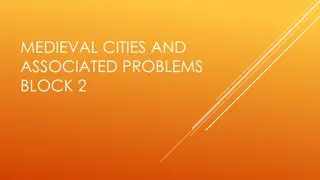Administration: Ancient, Medieval and colonial
The evolution of administration in India traces back to the earliest monarchial systems in the Vedic period, progressing through texts like Arthshastra and principles of hierarchy. Ancient administrators emphasized decentralization and hierarchical structures. Arthshastra acted as a manual for administrators, combining wealth and governance sciences. The king held a crucial role, embodying power and governance, serving the people's interests.
Download Presentation

Please find below an Image/Link to download the presentation.
The content on the website is provided AS IS for your information and personal use only. It may not be sold, licensed, or shared on other websites without obtaining consent from the author.If you encounter any issues during the download, it is possible that the publisher has removed the file from their server.
You are allowed to download the files provided on this website for personal or commercial use, subject to the condition that they are used lawfully. All files are the property of their respective owners.
The content on the website is provided AS IS for your information and personal use only. It may not be sold, licensed, or shared on other websites without obtaining consent from the author.
E N D
Presentation Transcript
Administration: Ancient, Administration: Ancient, Medieval and colonial Medieval and colonial FOR EC-II STUDENTS OF P.G. DEPARTMENT OF POLITICAL SCIENCE PATNA UNIVERSITY, PATNA SHEFALI ROY HEAD, DEPARTMENT OF POLITICAL SCIENCE, P.U. PATNA
Introduction Administration is derived from two terms ad and ministrare, ad means to serve and ministrare to manage The control or the act of managing something, for example a system, an organization or a business The group of people or part of a company that organizes and controls something Groups cooperating to accomplish common goals It is inclusive process of integrating human efforts so that a desired result is obtained.
definition Felix.A. Nigro says Administration is the organism and use of men and materials to accomplish a purpose. Luther Gullick says Administration has to do with getting things done; with the accomplishment of defined objectives. D. Waldo says Administration is a type of cooperative human effort that has a high degree of rationality. L.D.White says The art of administration is the direction, coordination and control of many persons to achieve some purpose or objective.
Ancient administration In India evolution of administration is from earliest known monarchial system, ever since Vedic period. It continues with Buddhist texts, Jain literature, dharamshastras, Puranas,Ramayana Mahabharata, Manu Smriti, Sukra Niti and Arthshastra. A detailed account of governance and administrative system was developed by Vishnu Gupta which laid the foundation of Mauryan administration Decentralization started from ancient India and a principle of hierarchy had been given a practical shape.
Arthshastra It can be studied in two ways: 1. As a study of state and society and 2. As a work on state and its functions or governance A.S. Altekar rightly says that Arthshastra is more a manual for the administrator than a work on polity. It is a combination of science of wealth and science of government. It talks about Swami, Amatya, Durg, Janapad, Kosh, Dand and Mitra in his Saptang theory, King, Ministers,Territory,Fortified Capital,The Army, The Treasury and TheAllies
King The king is regarded as the crucial element of administration. He has to play a positive and directive role in the governance He should be ideal, god fearing and must possess highest qualities of intellect, energy and leadership. He is the embodiment of power and state and King are indispensable. King is to serve the interests of his people like his children. King will have no personal likes and dislikes, he has to work for the welfare of the people. He is absolute but also servant of the people.
Ministers & Amatya Mantrin are ministers and amatyas are secretaries or councillors This is not very clear as both the terms have been used interchangeably He also talks about Prime- Minister who will actually govern over the people. He also refers to Raj Purohit, Priest who will always advise the King in discharge of his duties The Council of Ministers will function with secrecy and will compose inner and outer body of departments. The system was very complex and village was the basic unit of administration.
Principles of Administration Welfare state Personnel Administration talks about recruitment of each category of officers from King to lower personnel. Revenue Administration deals with Dharma and Kama. There was a Revenue Department with Samahartha as its head. Village Administration- Gopa was in charge of five to ten villages, above it was Sthanika,over four Sthanikas was Nagaraka
Mughal Administration The foundation of Mughal empire was laid at Panipat Babar established the Mughal rule in India Akbar adopted an aggressive policy and established a vast empire. Akbar is the pioneer in establishing an administrative set up in India. Emperor became pivot of the Administration and the shadow of God.( Zill-i-Allah) Mughal administration was highly centralized, no delegation of authority, no ministers, each one was accountable to the Emperor. Ain-I Akhbari gave detailed account of Administration
Departments of Mughal administration Military & Accounts House Hold Revenue Public Morals Religious Endowments Civil & Criminal Law Intelligence & Posts The Artillery
Provincial Administration Mughal administration was divided into provinces called Subahs Each Subah consisted of several Sarkars It was further divided into Mahals or Parganas In each Mahal was number of Villages known as Dihs Each of these were an administrative units There was mansabdari system which can be regarded as Bureaucratic system. There were diwane aam and khas but coercion was rampantly applied for aam public.
British Period Administration The seeds of present Administration is rooted in British Administration The East India Company was founded in 1660, it came for trade purposes but later it granted administrative powers to the traders. Lord Cornwallis is called the father of British Administration He came to India in1786 as the Governor General, he found corrupt practices in administration therefore he made the salary of traders very handsome.
Evolution of Administration In 1880 Lord Wellesly founded Fort William College at Kolkata for providing learning for Civil Services. Later Hailey Bury College was established in England. Army also tried to rule over the people, the glaring example is The First War of Independence. Police Administration and District Superintendent of Police post was created by Lord Cornwallis.
Acts of British Government Act of 1773-Regulating Act placed administration in the hands of British Officers Pitts India Act of 1784- placed administration under the Crown Charter Act of 1793- judicial and executive powers were separated Act of 1813 improved the status of education in India and judicial system was reformed Company Charter Act was renewed in 1833 and William Bentick became the Governor General of India and finally renewed in 1853
Acts cont Act of 1858- It ended company s rule and transferred the governance directly to the British Government Council Act of 1861- Indianization of Administration started Act of 1892- It was the result of Indian National Congress and it started elections partially. Indian Council Act of 1909- created communal cleavage in the Administration Act of 1919- It abolished racial discriminations against Indians in Administration
Government of India Act of 1935 This is the turning point of Indian Administration as there was an introduction of Federal Polity in India and establishment of provincial autonomy. There was a growth of All India Services Evolution of Federal Public Service Commission which after independence of India came to be known as Union Public Service Commission There was introduction of Local Self Government Procedural reforms in the working of Secretariat Finally evolution of Financial administration
Legacy of British administration in india Rule of Law Bureaucracy All India Services Federal Set up Parliamentary system Democratic set up Welfare state With a few changes, the basic structure of the Indian democracy carries the legacy of act of 1935 and the British rule in the Country.























